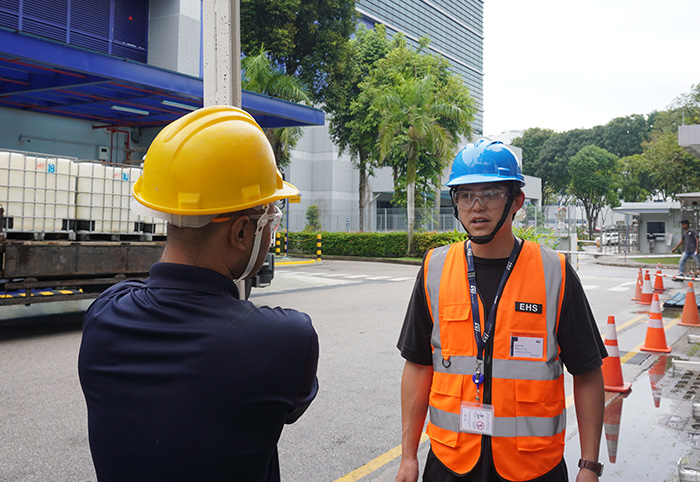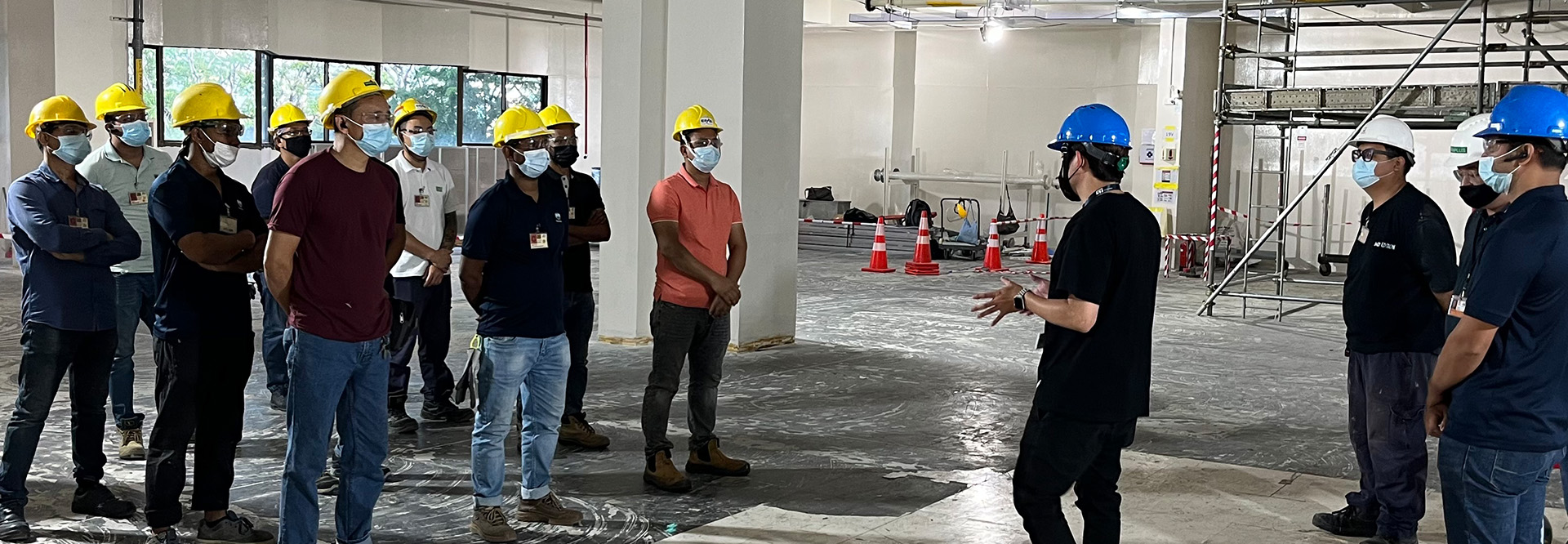Responsible supply chain
We aim to systematically assess, mitigate or eliminate sustainability risks in our operations and extended supply chain.
91%
of suppliers agree to comply with ST standards
460
supplier audits since 2015
1,700+
supplier employees trained
As a multinational company with a complex supply chain, our corporate social responsibility goes beyond our own operations and includes robust due diligence of all our suppliers and subcontractors. We are committed to partnering only with suppliers who share our values of respecting people and the environment. We regularly raise the standards expected from them and reinforce our internal capacity to address and remediate any adverse impacts identified. I 3-3 I
Our supply chain
42%
of our procurement spend in Europe
We procure materials, goods, and services from approximately 6,600 tier one suppliers of diverse types and sizes. They range from manufacturing subcontractors, material suppliers, equipment and spare-parts suppliers, to onsite service providers and labor agencies. Our procurement spend is split mainly between Asia (51%) and Europe (42%). We manage 32% of our procurement volume locally. The rest is managed centrally at corporate level. The analysis of our spend is an integral part of our risk assessment process. I 2-6 I 204-1 I
Procurement volume by category I 2-6 I
Adapting to new challenges
Anticipating and adapting to the new regulatory context
To better anticipate our compliance journey and create value from it, we pay close attention to recently adopted and upcoming regulations in Europe and the United States regarding due diligence in the supply chain, including forced labor prevention. As we move from due diligence disclosure obligations to import bans, the business impact of supply chain incidents and the need to adopt agile management systems and processes are increasing. In 2022:
- We developed an active public policy strategy and participated in several industry initiatives, including due diligence working groups with the Responsible Business Alliance (RBA), the European Semiconductor Industry Association (ESIA), the Fédération des Industries Électriques, Électroniques et de Communication (FIEEC) and Entreprises pour les Droits de l’Homme (EDH).
Monthly
taskforce on forced labor risk
- We organized due diligence committees involving different corporate organizations to discuss our supply chain sustainability management. We also continued our work, initiated in 2021, with our monthly cross-functional taskforce on forced labor. Its main objective is to adapt our supply chain management approach to new regulatory challenges.
- We maintained our efforts to screen all our tier one suppliers automatically and continually against restricted party lists (European and US sanctions lists).
When specific risks are identified, such as forced labor in our upstream supply chain, we require additional elements to improve product traceability and adapt our procurement decisions if necessary. Our responsible mineral sourcing program is an example (see Responsible mineral sourcing), and we participate in RBA working groups to identify opportunities to extend this due diligence to new raw materials, locations, or activities at risk.
More effective governance
New
Third-Party Management
organization in 2022
With increasing expectations around the sustainability of value chains, including human rights, climate change, ethics, quality, trade compliance, and business resilience, we faced two main challenges: consistency in cross-functional approaches and resources. To help address these issues, we created a new organization in 2022 under the procurement department called Third-Party Management (TPM). This has dedicated resources for enhancing our supplier onboarding, monitoring, and assessment capacities. The benefits of this new governance structure include:
- more resources to support our responsible supply chain program
- more synergies and leverage with procurement
- more effective organization and consistent processes
- alignment across all organizations, with domain experts interfacing with TPM
Risk management
Our overall approach to managing our supply chain starts with the robust identification of risks. This enables us to take targeted actions to control these risks and remediate any negative impacts identified.
Business risks
To secure business continuity, we categorize strategic suppliers according to spend level, product scarcity, and the availability of alternative sources. We assess these business-critical suppliers using real-time supplier information, obtained via an artificial intelligence platform. Any events potentially affecting our supply chain are detected and help us to take action to strengthen our resilience.
Sustainability risks
To identify, manage, prevent, and mitigate sustainability risks, we conduct regular risk assessments of our supply chain during the lifecycle of our business relationship.
100%
of new material suppliers assessed on sustainability risks
- We assess risks before onboarding suppliers. In 2022, 100% of our new material suppliers were assessed for sustainability risks, including risks on forced labor, safety, and the environment.
- We conduct an annual risk assessment of our tier one suppliers based on specific risk criteria. These include supplier activity risks and supplier location risks extracted from a supply chain intelligence platform using both publicly available and audit data. We refine the process according to spend and the regular presence of suppliers on site. At the end of 2022, we identified 340 suppliers across 535 facilities as being high risk in terms of sustainability.
- When specific risks, such as forced labor, are identified in our upstream supply chain, we may extend our due diligence to sub-tier suppliers. In 2022, we asked 15 raw material suppliers additional questions to better assess the risk of forced labor through upstream sourcing.
Impact-driven monitoring
Once onboarded, suppliers must declare they have read and understood ST’s business ethics and corporate responsibility statement, and that they agree to comply with the latest version of the RBA code of conduct and apply it in their own supply chain.
In addition, we require our high-risk suppliers to undertake a three-step process.
Commitment letter
Suppliers sign a supply chain responsibility commitment letter, agreeing to comply with the RBA code, to complete self-assessment questionnaires and accept second or third-party audits.
Self-Assessment Questionnaire (SAQ)
Suppliers complete an RBA self-assessment. The results enable us to identify areas that require attention.
RBA-based audit and follow-up
Suppliers receive a third-party RBA Validated Assessment Program (VAP) audit or a second-party RBA-based audit to monitor and control compliance and address areas of non-compliance with corrective actions.
In 2022:
- 99% of our high-risk suppliers signed the RBA commitment letter
- 394 suppliers’ facilities completed a self-assessment questionnaire
- 116 corporate social responsibility audits were conducted in one year – the most ever
All audited suppliers with non-conformances must implement corrective actions. These are verified in a follow-up closing audit.
If the supplier is unable or unwilling to meet these requirements, we may impose sanctions. These could include:
- a warning letter from executive management
- selecting alternative products or services to decrease the supplier’s market share
- temporary or definitive termination of the contract and the supplier being blacklisted
Top audit findings of material, equipment/spare-parts suppliers and subcontractors(1) I 308-2 I 414-2 I 409-1 I
Top audit findings of local service providers(1) I 308-2 I 414-2 I 409-1 I
US$248,000
of recruitment fees reimbursed to workers
Detection and remediation are the two main approaches to decrease major risks. In 2022, remediation measures obliged our suppliers to reimburse US$248,000 in recruitment fees unfairly paid by workers, an 80% increase on 2021.
Focus

Raising the bar for subcontractor performance
Our manufacturing subcontractors are an important part of our procurement activity, and we consider most of them as high-risk suppliers. In 2022, we raised our expectations relating to social responsibility and environmental management by introducing strategic objectives and monthly monitoring of these objectives.
More specifically, for our top subcontractors’ back-end facilities we:
- organized dedicated strategy meetings
- developed a roadmap to have 100% RBA third-party audited
- achieved ISO 14001 and ISO 45001 certifications for them all
- set health and safety objectives (recordable case rate and severity rate)
- required them to adopt carbon neutrality objectives: 100% of sites have set annual reduction targets to reach carbon neutrality
In addition to this, we enhanced environmental reporting on carbon emissions, energy consumption, water, and waste KPIs for our top front-end and back-end subcontractors, representing 95% of our subcontracting spend. This data will enable us to set a baseline for progress and for developing lifecycle assessment in our supply chain.
We also introduced awareness and communication sessions for new onboarded subcontractors to develop their understanding and commitment around social and environmental management.
Capacity building on sustainability
Engaging our buyers
From December 2021 and throughout 2022, all ST buyers were enrolled in the RBA’s responsible procurement training program, with 89 buyers completing at least one training module.
In addition, we regularly invite our procurement community to participate in responsible supply chain quarterly calls where we present the most recent updates on regulations, risk identification, and monitoring processes.
Training our suppliers
We not only manage our suppliers appropriately, we also support them in raising their awareness of sustainable practices. We provide e-learning on risk areas such as labor (including working hours and forced labor), ethics, health and safety and the environment, and through dedicated awareness sessions where necessary.

Ng Wee Keat
Assistant Director, GMP Recruitment Services (S) Pte Ltd, Singapore
The GMP Group has always been a supporter of ST’s supplier engagement program based on the Responsible Business Alliance (RBA) standard. The RBA e-learning platform allows us to conveniently learn or refresh our knowledge and understanding, keeping us up to date with the RBA’s code of conduct. Since using the platform, it has greatly helped us in our recruitment process by holding us accountable for responsible business conduct and practices.”
In 2022, more than 250 supplier employees, representing around 100 different companies, went through our customized learning paths in the RBA e-learning platform. In addition, our sustainability champions organized awareness and training sessions. Overall, more than 1,700 supplier employees went through training actions through e-learnings, meetings, webinars and workers’ voice channels in 2022.
Grievance reporting
Like our own employees, our suppliers and their workers have the right to use the independent multilingual Ethics Hotline, accessible on our website (see www.st.com), to share any concerns. This channel is reachable online or by phone in local languages and allows reports to be made anonymously if desired. In case of grievances, ST and the supplier must ensure complainants are protected against any retaliation. I 3-3 I
Contributing to the Sustainable Development Goals
Our commitments and programs as described above contribute to:
SDG target 8.7 – Take immediate and effective measures to eradicate forced labor, end modern slavery and human trafficking, and secure the prohibition and elimination of the worst forms of child labor.
SDG target 8.8 – Protect labor rights and promote safe and secure working environments for all workers.
SDG target 17.16 – Enhance the global partnership for sustainable development, complemented by multi-stakeholder partnerships that mobilize and share knowledge, expertise, technology and financial resources, to support the achievement of the sustainable development goals in all countries, in particular developing countries.
2025 sustainability goal |
Status |
Comments |
SG20: Conduct an annual risk assessment of our supply chain and audit 100% of our high-risk suppliers by 2025. |
Risk assessment conducted |
Annual sustainability goal |
Status |
Comments |
≥90% of suppliers at risk for sustainability signed an agreement to comply with the RBA code of conduct. |
99% |


